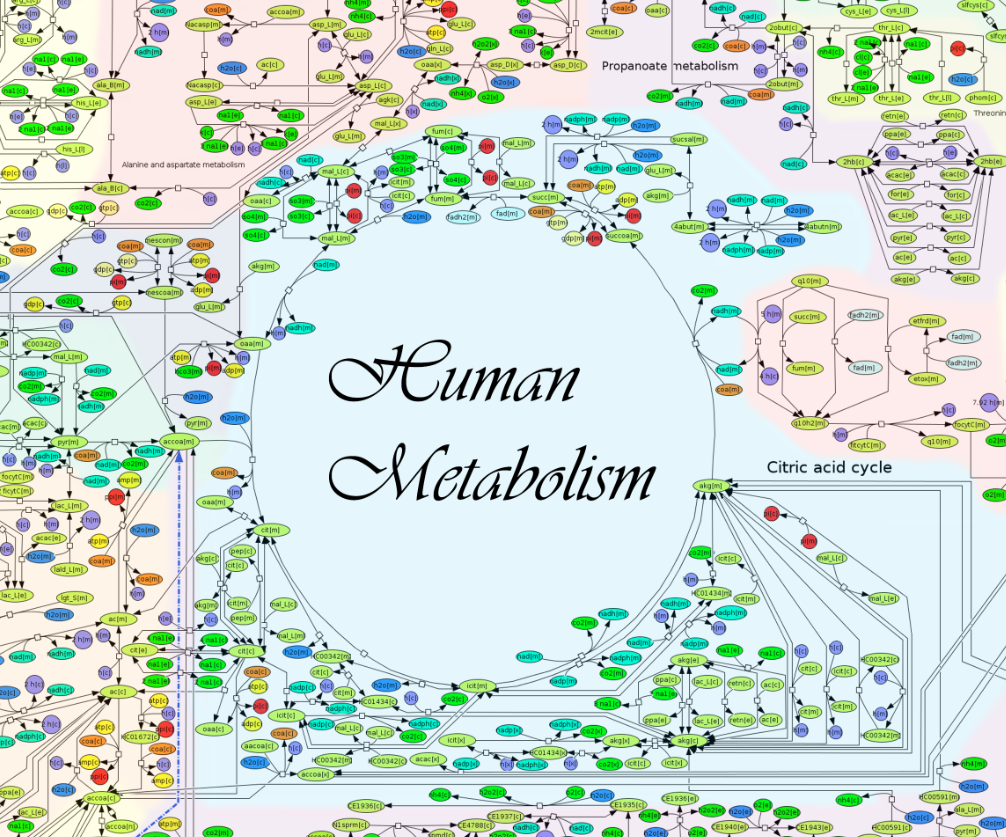
Research Interests
Human metabolism is a complex and well-tuned system. While human body tolerates a wide range of fluctuations in both macro- and micro- environments, its distortion in acute yet forceful as well as chronic states can lead to severe dysfunction. My research interests are in understanding events in and mechanisms of human metabolic diseases and cancer, and help to translate the knowledge and technologies to improve medical application in these fields.

 left: Darwin's drawing of the human boday.
right: Recon X, the reconstructed human metabolic network.
left: Darwin's drawing of the human boday.
right: Recon X, the reconstructed human metabolic network.
The human cells and organs function in a rich and interconnected environment. Viewing the entire system as a whole can provide us a lot more valuable information than just looking at one piece at a time. The advent of the omics technologies has greatly advanced biology research in recent years by providing information of bio-molecules in a systematic manner. Microarray and nucleotide sequencing have enabled individual and personalized [1], family-based [2], and population-wide [3,4] survey of genetic factors that predispose individuals to certain diseases, successfully aided clinical diagnosis, and helped targeted or comprehensive clinical prognostication of disease risk and drug response. Mass spectrometry-based proteomics has revealed biomarkers for tumor generation and progression [5] as well as for other diseases [6], classified tumor subtypes [7,8], provided toxicity mechanisms [9], and shed right on antibiotic resistance [10]. Other omics, such as metabolomics, transcriptomics, methylomics, and so on, have also played essential roles in deciphering human diseases. With my over ten years research experience in the omics field, I aim to continue to apply these technologies to address key questions in the areas of human metabolic diseases and cancer.
 Navigating cancer network attractors for tumor-specific therapy.
Nat Biotech 30, 842-848 (2012)
Navigating cancer network attractors for tumor-specific therapy.
Nat Biotech 30, 842-848 (2012)
I have 7+ years hands on experience culturing cells, running mass spectrometers and performing LC-MS/MS quantitative proteomcis and phosphoproteomics experiments (check out my publication records here). Currently I am focusing on bioinformatic analysis and algorithm development to address a few aspects of human diseases:
1. Discover genetic factors that predispose individuals to certain human quantitative-trait diseases by using the whole-genome or whole-exome sequencing technologies. - I participate the Million Veteran Program.
2. Develop algorithms to accurately detect heterogeneous mutation events in cancer and characterize the mutation events from the functional point-of-view. - I participate Stanford School of Medicine's effort in building clinical-grade genome sequencing and annotation.
3. Integrate various types of biomolecule measurements with the EMR (electronic medical records) for the patients, e.g. genomics, transcriptomics, proteomics, metabolomics, imaging, etc.
Reference 1. Ashley EA, Butte AJ, et al. Clinical assessment incorporating a personal genome. Lancet. 2010 May 1;375(9725):1525-35. 2. Dewey FE, Chen R, et al. Phased whole-genome genetic risk in a family quartet using a major allele reference sequence. PLoS Genet. 2011 Sep;7(9):e1002280. 3. Hara K, Fujita H, et al. Genome-Wide Association Study Identifies Three Novel Loci for Type 2 Diabetes. Hum Mol Genet. 2013 Aug 14. 4. Cohorts for Heart and Aging Research in Genetic Epidemiology (CHARGE) Consortium, et al. Whole-genome sequence-based analysis of high-density lipoprotein cholesterol. Nat Genet. 2013 Aug;45(8):899-901. 5. Olsson N, Carlsson P, et al. Grading breast cancer tissues using molecular portraits. Mol Cell Proteomics. 2013 Aug 27. 6. Delles C, Schiffer E,et al. Urinary proteomic diagnosis of coronary artery disease: identification and clinical validation in 623 individuals. J Hypertens. 2010 Nov;28(11):2316-22. 7. Deeb SJ, D'Souza RC, et al. Super-SILAC allows classification of diffuse large B-cell lymphoma subtypes by their protein expression profiles. Mol Cell Proteomics. 2012 May;11(5):77-89. 8. Zhang F, Chen JY. Breast cancer subtyping from plasma proteins. BMC Med Genomics. 2013;6 Suppl 1:S6. 9. Schirle M, Bantscheff M, et al. Mass spectrometry-based proteomics in preclinical drug discovery. Chem Biol. 2012 Jan 27;19(1):72-84. 10. Lima TB, Pinto MF, et al. Bacterial resistance mechanism: what proteomics can elucidate. FASEB J. 2013 Apr;27(4):1291-303.